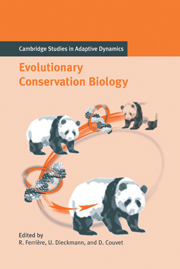Book contents
- Frontmatter
- Contents
- Contributing Authors
- Acknowledgments
- Notational Standards
- 1 Introduction
- Part A Theory of Extinction
- Part B The Pace of Adaptive Responses to Environmental Change
- 5 Responses to Environmental Change: Adaptation or Extinction
- 6 Empirical Evidence for Rapid Evolution
- 7 Genetic Variability and Life-history Evolution
- 8 Environmental Stress and Quantitative Genetic Variation
- Part C Genetic and Ecological Bases of Adaptive Responses
- Part D Spatial Structure
- Part E Community Structure
- References
- Index
- The International Institute for Applied Systems Analysis
5 - Responses to Environmental Change: Adaptation or Extinction
Published online by Cambridge University Press: 15 August 2009
- Frontmatter
- Contents
- Contributing Authors
- Acknowledgments
- Notational Standards
- 1 Introduction
- Part A Theory of Extinction
- Part B The Pace of Adaptive Responses to Environmental Change
- 5 Responses to Environmental Change: Adaptation or Extinction
- 6 Empirical Evidence for Rapid Evolution
- 7 Genetic Variability and Life-history Evolution
- 8 Environmental Stress and Quantitative Genetic Variation
- Part C Genetic and Ecological Bases of Adaptive Responses
- Part D Spatial Structure
- Part E Community Structure
- References
- Index
- The International Institute for Applied Systems Analysis
Summary
Introduction
All populations are confronted with a plethora of environmental changes and must adapt, shift their range, or face extinction. Adaptation may take two forms:
The first option involves physiological acclimatization through phenotypic plasticity at the level of individuals.
Second, the genetic composition of populations may change through natural selection, a change that favors some genotypes at the expense of others.
Whereas plastic adaptation can only cope with environmental change of a limited extent, genetic adaptation allows populations to persist outside their previous tolerance ranges. Therefore, genetic adaptation is of primary concern in conservation biology, in terms of what is required to cope with major or sustained environmental changes. Feasibility and speed of genetic adaptations in response to environmental change depend on a variety of factors, such as a population's genetic diversity, the population size, generation time, and reproduction excess.
This chapter is organized as follows. In Section 5.2 we review the different types of abiotic environmental change that occur in nature, with an emphasis on their characteristic spatial and temporal scales. Section 5.3 explains how changes in local climate affect the physiological and phenological aspects of life histories and shows that evolutionary adaptations to altered climate conditions can be rapid. Sections 5.4 and 5.5 extend this conclusion to responses to thermal stress and pollution, and Section 5.6 highlights the special evolutionary challenges experienced by endangered species.
- Type
- Chapter
- Information
- Evolutionary Conservation Biology , pp. 85 - 100Publisher: Cambridge University PressPrint publication year: 2004
- 23
- Cited by

